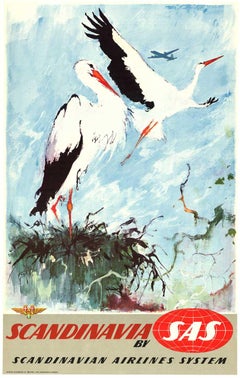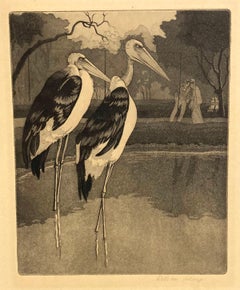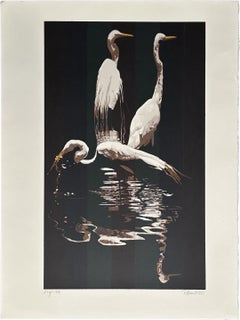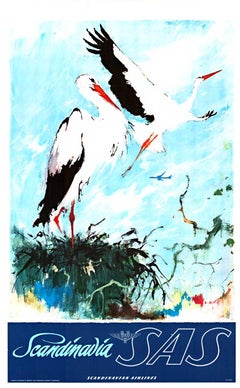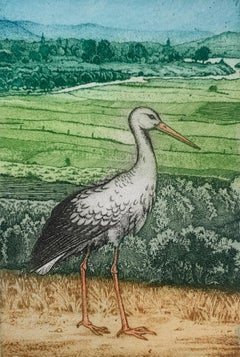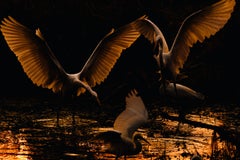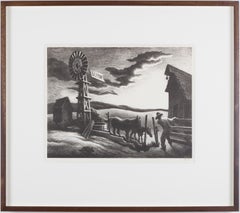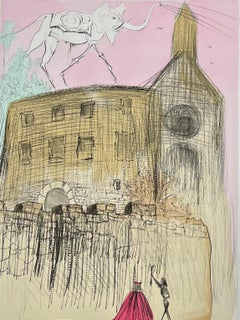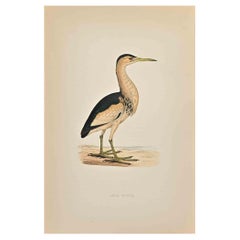Stork Animal Prints
to
1
6
2
2
2
2
Overall Width
to
Overall Height
to
8
2
1
1
1
1
1
1
1
5
5
3
2
1
1
10
4
45
2,717
1,740
1,451
1,084
860
565
493
456
421
402
357
353
316
253
218
191
174
148
146
4
3
3
2
1
5
3
Art Subject: Stork
Original "Scandinavia by SAS, Scandiavian Airlines System vintage travel poster
Located in Spokane, WA
Original first edition printing of Scandinavia by SAS, Scandinavian Airlines System. The first edition has a greyish panel along the bottom. The poster also features the SAS logo...
Category
1960s American Modern Animal Prints
Materials
Offset
William Sharp, Lincoln Park Marabous (probably Chicago)
Located in New York, NY
William Sharp, largely known as a court reporter, was based in New York City. Probably this scene of Lincoln Park Marabous is Chicago. There are several ...
Category
Mid-20th Century American Modern Animal Prints
Materials
Etching
Three Egrets 1980 Signed Limited Edition Screen Print
By Fran Bull
Located in Rochester Hills, MI
Artist: Fran Bull
Title: Three Egrets
Year: 1980
Print: Screen Print on Rives BFK White paper
Size: 22'' x 30'' inches
Edition: Signed in pencil and marked 230/250
Fran Bull is b...
Category
1980s Photorealist Animal Prints
Materials
Screen
Original "S.A.S. Scandinavia Airlines" vintage travel poster with 2 storks
Located in Spokane, WA
Scandinavia by SAS - Storks. Original vintage European travel poster created by the artist Otto Nielsen. This poster features the prop plane and would be SAS's earliest printing of the image. Archival linen-backed, fine condition, ready to frame.
Beautiful travel poster for Scandinavian Airlines. Excellent condition with wonderful artistry and soft warm colors.
SAS was founded in 1946 as a consortium of the national airlines of Denmark, Norway, and Sweden. Over the years, it has played a crucial role in connecting Scandinavia with the rest of the world.
Otto Nielsen was a Danish artist known for contributing to Scandinavian Airlines System (SAS) posters. Born on December 29, 1916, in Copenhagen, Denmark, Nielsen became a prominent figure in the world of graphic design and illustration, particularly for his work with SAS. Otto Nielsen created a series of iconic posters for SAS during the mid-20th century. His artwork often featured stylized and colorful depictions of Scandinavian landscapes, culture, and landmarks. These posters were part of SAS's marketing campaigns to promote air travel to and from Scandinavia.
This is an Original Lithograph Vintage Poster; it is not a reproduction.
The Vintage Poster has been working with collectors worldwide, helping them with their original vintage poster collections...
Category
1960s American Modern Animal Prints
Materials
Offset
A stork. Contemporary figurative print, Animal, Bird, Colourful, Polish artist
Located in Warsaw, PL
Small scale contemporary figurative etching print by Polish artist Marian Bocianowski. Artwork depicts a stork standing in a meadow. There is rural landscape in the backround. Main ...
Category
2010s Other Art Style Figurative Prints
Materials
Etching, Paper
Animal Nature Photography Large White Birds Great Egrets 2/8 India Dawn Wildlife
Located in Norfolk, GB
Aditya Dicky Singh Untitled Photograph on fine-art Hahnemuhle archival paper
44" x 65" unframed (112cm x 165cm) 2017
Edition 3/8
*Should you w...
Category
2010s Contemporary Color Photography
Materials
Archival Ink, Archival Paper
Grallae - Etching by Jean Francois Turpin-1831
Located in Roma, IT
This is one of the illustrations of " Dizionario di scienze naturali " (Natural sciences dictionary) edited by Battelli nel 1831. The work was made of 29 volumes, containing hundred...
Category
1830s Modern Animal Prints
Materials
Etching
Ibis - Mixed Colored Woodcut Print - 1870
Located in Roma, IT
Ibis is a modern artwork realized in 1870. Woodcut print, hand colored, published by London, Bell & Sons, 1870. Name of the bird printed in plate.
This work is part of a print sui...
Category
1870s Modern Figurative Prints
Materials
Woodcut
Heron and Stork - Etching by Johann Friedrich Naumann - 1840
Located in Roma, IT
Heron and Stork is an Etching hand colored realized by Gotthilf Heinrich von Schubert - Johann Friedrich Naumann, Illustration from Natural history of birds in pictures, published by...
Category
1840s Modern Figurative Prints
Materials
Etching
Heron - Woodcut Print by Alexander Francis Lydon - 1870
Located in Roma, IT
Heron is a modern artwork realized in 1870 by the British artist Alexander Francis Lydon (1836-1917).
Woodcut print on ivory-colored paper.
Hand-colored, published by London, Bell ...
Category
1870s Modern Figurative Prints
Materials
Woodcut
White Stork - Woodcut Print by Alexander Francis Lydon - 1870
Located in Roma, IT
White Stork is a modern artwork realized in 1870 by the British artist Alexander Francis Lydon (1836-1917).
Woodcut print on ivory-colored paper.
Hand-colored, published by London,...
Category
1870s Modern Figurative Prints
Materials
Woodcut
Scandinavia by SAS – Original Vintage Airline Poster
Located in Zurich, CH
Original Vintage Airline Poster by the Danish illustrator Otto Nielsen (1916 – 2000). He created several designs commissioned by the S...
Category
Mid-20th Century Animal Prints
Materials
Paper
Crane, Color Nature Photography by Geoffrey Baris, Wildlife, Bird, Close-up
Located in New York, NY
Crane, Color Nature Photography by Geoffrey Baris
Archival pigment print on museum fine art paper
Edition of 7
Includes certificate of authenticity. Signed and numbered by artist.
C...
Category
2010s Contemporary Color Photography
Materials
Color, Archival Pigment
John Gould - Ciconia Nigra from 'Birds of Great Britain' C. 1862
By John Gould
Located in BRUCE, ACT
Ciconia Nigra - John Gould lithograph with hand-coloured
size 54 cm X 36 cm
This remarkable ornithology lithograph with hand-finished colour is ...
Category
Early 18th Century Animal Prints
Materials
Lithograph
Related Items
Nebraska Evening
Located in London, GB
A fine impression with good margins published by Associated American Artists.
Category
1940s American Modern Landscape Prints
Materials
Lithograph
Salvador Dalí, "Le Chateau de Gala", original etching, hand colored, signed
Located in Chatsworth, CA
Salvador Dalí
Le Chateau de Gala (Gala's Castle) from After 50 Years of Surrealism
Original etching, hand colored
1974
Image size: 15 3/...
Category
1970s Modern Landscape Prints
Materials
Etching
Tiger 1, David Hunt, Animal Art, Realist Print, Affordable Artwork
By David Hunt
Located in Deddington, GB
David Hunt
Tiger 1
Limited Edition Giclee Print
Edition 10
Framed Size: H 84cm x W 84cm x D 3.5cm
Sold Framed
Please note that in situ images are purely an indication of how a piece ...
Category
21st Century and Contemporary Photorealist Animal Prints
Materials
Paper, Giclée
H 33.08 in W 33.08 in D 1.38 in
The Passing Parade, 20th Century Lithograph, Southwestern Desert with Antelope
By Ila Mae McAfee
Located in Denver, CO
This stunning original lithograph, titled The Passing Parade, is a signed piece by renowned American artist Ila Mae McAfee (1897-1995). Created in the 20th century, the artwork depic...
Category
20th Century American Modern Animal Prints
Materials
Lithograph
Alexander Calder Circus Reproduction Lithograph After a Drawing
Located in Surfside, FL
(after) Alexander Calder
"Calder's Circus" offset lithograph on wove paper after drawings by the artist
Published by Art in America and Perls gallery in 1964 (from drawings done in the 1930's)
these range slightly in size but they are all about 13 X 17 inches (with minor variations in size as issued.) These have never been framed. The outer folio is not included just the one lithograph.
James Sweeny from the introduction “The fame of Calder’s circus spread quickly between the years 1927 and 1930. All the Paris art world came to know it. It brought him his first great personal success. But what was more important, the circus also provided the first steps in Calder’s development as an original sculptor”
Clive Gray wrote ”A visit to the studio of Alexander Calder led to the chance discovery of some hundred masterful circus drawings completed over thirty years ago. We publish, for the first time, a choice of sixteen from that group.” With signed introduction by Miro.
These whimsical drawings, done in the style of wire sculpture, include acrobats, clowns, jugglers, trapeeze artists, an elephant, dog and lion. they are great.
Alexander Calder is widely considered to be one of the most important American sculptors of the 20th century. He is best known for his colorful, whimsical abstract public sculptures and his innovative mobiles, kinetic sculptures powered by motors or air currents, which embraced chance in their aesthetic. Born into a family of accomplished artists, Calder's work first gained attention in Paris in the 1930s and was soon championed by the Museum of Modern Art in New York, resulting in a retrospective exhibition in 1943. Major retrospectives were also held at the Solomon R. Guggenheim Museum (1964) and the Museum of Contemporary Art, Chicago (1974). Calder’s work is in many permanent collections, most notably in the Whitney Museum of American Art, but also the Guggenheim Museum; the Museum of Modern Art; the National Gallery of Art, Washington, D.C.; and the Centre Georges Pompidou. He produced many large public works, including .125 (at JFK Airport, 1957), Pittsburgh (Carnegie International prize winner 1958, Pittsburgh International Airport) Spirale (UNESCO in Paris, 1958), Flamingo and Universe (both in Chicago, 1974), and Mountains and Clouds (Hart Senate Office Building, Washington, D.C., 1976). Although primarily known for his sculpture, Calder was a prodigious artist with a restless creative spirit, whose diverse practice included painting and printmaking, miniatures (such as his famous Cirque Calder), children’s book illustrations, theater set design, jewelry design, tapestry and rug works, and political posters. Calder was honored by the US Postal Service with a set of five 32-cent stamps in 1998, and received the Presidential Medal of Freedom, posthumously in 1977, after refusing to receive it from Gerald Ford one year earlier in protest of the Vietnam War.
Calder moved to New York and enrolled at the Art Students League, studying briefly with Thomas Hart Benton, George Luks, Kenneth Hayes Miller, and John Sloan. While a student, he worked for the National Police Gazette where, in 1925, one of his assignments was sketching the Ringling Bros. and Barnum & Bailey Circus. Calder became fascinated with the action of the circus, a theme that would reappear in his later work.
In 1926, Calder moved to Paris, enrolled in the Académie de la Grande Chaumière, and established a studio at 22 rue Daguerre in the Montparnasse Quarter. In June 1929, while traveling by boat from Paris to New York, Calder met his future wife, Louisa James (1905-1996), grandniece of author Henry James and philosopher William James. They married in 1931. While in Paris, Calder met and became friends with a number of avant-garde artists, including Fernand Léger, Jean Arp, and Marcel Duchamp. Cirque Calder (on view at the Whitney Museum of American Art at present) became popular with the Parisian avant-garde. He also invented wire sculpture, or "drawing in space," and in 1929 he had his first solo show of these sculptures in Paris at Galerie Billiet. Hi! (Two Acrobats) in the collection of the Honolulu Museum of Art is an early example of the artist's wire sculpture. The painter Jules Pascin, a friend of Calder's from the cafes of Montparnasse, wrote the preface to the catalog. A visit to Piet Mondrian's studio in 1930, where he was impressed by the environment-as-installation, "shocked" him into fully embracing abstract art, toward which he had already been tending.
Dating from 1931, Calder’s sculptures of discrete movable parts powered by motors were christened “mobiles” by Marcel Duchamp, a French pun meaning both "motion" and "motive." At the same time, Calder was also experimenting with self-supporting, static, abstract sculptures, dubbed "stabiles" by Jean Arp in 1932 to differentiate them from mobiles.
Public commissions increasingly came his way in the 1960s. Notable examples are .125 for JFK Airport in 1957, Spirale for UNESCO in Paris 1958 and Trois disques, commissioned for Expo 67 in Montreal, Quebec, Canada. Calder's largest sculpture at 25.7 meters high was El Sol Rojo, constructed outside the Aztec Stadium for the 1968 Summer Olympics "Cultural Olympiad" events in Mexico City. Many of his public works were commissioned by renowned architects; I.M. Pei commissioned his La Grande Voile (1966), a 25-ton, 40-foot high stabile for the Massachusetts Institute of Technology.
Part of Calder's repertoire includes pivotal stage sets for more than a dozen theatrical productions, including Nucléa, Horizon, and most notably, Martha Graham’s Panorama (1935), a production of the Erik Satie symphonic drama Socrate (1936), and later, Works in Progress (1968).
In addition to sculptures, Calder painted throughout his career, beginning in the early 1920s. He picked up his study of printmaking in 1925, and continued to produce illustrations for books and journals.As Calder’s professional reputation expanded in the late 1940s and 1950s, so did his production of prints. Masses of lithographs based on his gouache paintings hit the market, and deluxe editions of plays, poems, and short stories illustrated with fine art prints by Calder became available for sale.
One of Calder's most celebrated and unconventional undertakings was a commission from Dallas-based Braniff International Airways to paint a full-size Douglas DC-8-62 four-engined jet as a "flying canvas."
Calder created over 2,000 pieces of jewelry over the course of his career, many of them as gifts for friends and relatives. For his lifelong friend Joan Miró, he set a shard of a broken porcelain vessel in a brass ring. Peggy Guggenheim received enormous silver mobile earrings and later commissioned a hammered silver headboard...
Category
1930s American Modern Animal Prints
Materials
Lithograph
Alexander Calder Circus Reproduction Lithograph of a Drawing
Located in Surfside, FL
(after) Alexander Calder
"Calder's Circus" offset lithograph on wove paper a reproduction lithograph after the drawings by the artist
Published by Art in America and Perls gallery in 1964 (from drawings done in the 1930's)
these range slightly in size but they are all about 13 X 17 inches (with minor variations in size as issued.) These have never been framed. The outer folio is not included just the one lithograph.
James Sweeny from the introduction “The fame of Calder’s circus spread quickly between the years 1927 and 1930. All the Paris art world came to know it. It brought him his first great personal success. But what was more important, the circus also provided the first steps in Calder’s development as an original sculptor”
Clive Gray wrote ”A visit to the studio of Alexander Calder led to the chance discovery of some hundred masterful circus drawings completed over thirty years ago. We publish, for the first time, a choice of sixteen from that group.” With signed introduction by Miro.
These whimsical drawings, done in the style of wire sculpture, include acrobats, clowns, jugglers, trapeeze artists, an elephant, dog and lion. they are great.
Alexander Calder is widely considered to be one of the most important American sculptors of the 20th century. He is best known for his colorful, whimsical abstract public sculptures and his innovative mobiles, kinetic sculptures powered by motors or air currents, which embraced chance in their aesthetic. Born into a family of accomplished artists, Calder's work first gained attention in Paris in the 1930s and was soon championed by the Museum of Modern Art in New York, resulting in a retrospective exhibition in 1943. Major retrospectives were also held at the Solomon R. Guggenheim Museum (1964) and the Museum of Contemporary Art, Chicago (1974). Calder’s work is in many permanent collections, most notably in the Whitney Museum of American Art, but also the Guggenheim Museum; the Museum of Modern Art; the National Gallery of Art, Washington, D.C.; and the Centre Georges Pompidou. He produced many large public works, including .125 (at JFK Airport, 1957), Pittsburgh (Carnegie International prize winner 1958, Pittsburgh International Airport) Spirale (UNESCO in Paris, 1958), Flamingo and Universe (both in Chicago, 1974), and Mountains and Clouds (Hart Senate Office Building, Washington, D.C., 1976). Although primarily known for his sculpture, Calder was a prodigious artist with a restless creative spirit, whose diverse practice included painting and printmaking, miniatures (such as his famous Cirque Calder), children’s book illustrations, theater set design, jewelry design, tapestry and rug works, and political posters. Calder was honored by the US Postal Service with a set of five 32-cent stamps in 1998, and received the Presidential Medal of Freedom, posthumously in 1977, after refusing to receive it from Gerald Ford one year earlier in protest of the Vietnam War.
Calder moved to New York and enrolled at the Art Students League, studying briefly with Thomas Hart Benton, George Luks, Kenneth Hayes Miller, and John Sloan. While a student, he worked for the National Police Gazette where, in 1925, one of his assignments was sketching the Ringling Bros. and Barnum & Bailey Circus. Calder became fascinated with the action of the circus, a theme that would reappear in his later work.
In 1926, Calder moved to Paris, enrolled in the Académie de la Grande Chaumière, and established a studio at 22 rue Daguerre in the Montparnasse Quarter. In June 1929, while traveling by boat from Paris to New York, Calder met his future wife, Louisa James (1905-1996), grandniece of author Henry James and philosopher William James. They married in 1931. While in Paris, Calder met and became friends with a number of avant-garde artists, including Fernand Léger, Jean Arp, and Marcel Duchamp. Cirque Calder (on view at the Whitney Museum of American Art at present) became popular with the Parisian avant-garde. He also invented wire sculpture, or "drawing in space," and in 1929 he had his first solo show of these sculptures in Paris at Galerie Billiet. Hi! (Two Acrobats) in the collection of the Honolulu Museum of Art is an early example of the artist's wire sculpture. The painter Jules Pascin, a friend of Calder's from the cafes of Montparnasse, wrote the preface to the catalog. A visit to Piet Mondrian's studio in 1930, where he was impressed by the environment-as-installation, "shocked" him into fully embracing abstract art, toward which he had already been tending.
Dating from 1931, Calder’s sculptures of discrete movable parts powered by motors were christened “mobiles” by Marcel Duchamp, a French pun meaning both "motion" and "motive." At the same time, Calder was also experimenting with self-supporting, static, abstract sculptures, dubbed "stabiles" by Jean Arp in 1932 to differentiate them from mobiles.
Public commissions increasingly came his way in the 1960s. Notable examples are .125 for JFK Airport in 1957, Spirale for UNESCO in Paris 1958 and Trois disques, commissioned for Expo 67 in Montreal, Quebec, Canada. Calder's largest sculpture at 25.7 meters high was El Sol Rojo, constructed outside the Aztec Stadium for the 1968 Summer Olympics "Cultural Olympiad" events in Mexico City. Many of his public works were commissioned by renowned architects; I.M. Pei commissioned his La Grande Voile (1966), a 25-ton, 40-foot high stabile for the Massachusetts Institute of Technology.
Part of Calder's repertoire includes pivotal stage sets for more than a dozen theatrical productions, including Nucléa, Horizon, and most notably, Martha Graham’s Panorama (1935), a production of the Erik Satie symphonic drama Socrate (1936), and later, Works in Progress (1968).
In addition to sculptures, Calder painted throughout his career, beginning in the early 1920s. He picked up his study of printmaking in 1925, and continued to produce illustrations for books and journals.As Calder’s professional reputation expanded in the late 1940s and 1950s, so did his production of prints. Masses of lithographs based on his gouache paintings hit the market, and deluxe editions of plays, poems, and short stories illustrated with fine art prints by Calder became available for sale.
One of Calder's most celebrated and unconventional undertakings was a commission from Dallas-based Braniff International Airways to paint a full-size Douglas DC-8-62 four-engined jet as a "flying canvas."
Calder created over 2,000 pieces of jewelry over the course of his career, many of them as gifts for friends and relatives. For his lifelong friend Joan Miró, he set a shard of a broken porcelain vessel in a brass ring. Peggy Guggenheim received enormous silver mobile earrings and later commissioned a hammered silver headboard...
Category
1930s American Modern Animal Prints
Materials
Lithograph
"Full Cry" - Mid Century Horse Hunt Figurative Landscape
Located in Soquel, CA
A dynamic mid 20th century copy of a lithograph that depicts Englishmen on horseback giving chase with a pack of beagle-type dogs running in the background. by John Frederick Herring...
Category
1960s Romantic Landscape Prints
Materials
Offset, Paper
H 20.75 in W 28.25 in D 1.5 in
Chuzo Tamotzu Litho, Southwestern Landscape with Donkeys & Mission
Located in New York, NY
Chuzo Tamotzu (1891-1975)
Untitled (Southwestern Scene), c. 1950
Lithograph
Sight: 12 1/2 x 16 in.
Framed: 19 1/2 x 23 1/4 x 1 in.
Edition 14 of 30
Numbered lower left, signed lower...
Category
Mid-20th Century Modern Landscape Prints
Materials
Lithograph
H 19.5 in W 23.25 in D 1 in
'Lida & the Swan', New York Armory Show, Ashcan School, ASL, NYMOMA, AIC, LACMA
Located in Santa Cruz, CA
Signed lower right, 'Arthur B. Davies' for Arthur Bowen Davies (American, 1862-1928) and created circa 1915.
An early twentieth-century sugar-lift aquatint showing Zeus in the guise of a swan, reclining and cradling Lida in his wings while King Tyndareus ponders the mutability of human circumstance.
Born in Utica, New York, Arthur Davies attended the Chicago Academy of Design from 1879 to 1882. He furthered his studies at the Chicago Art Institute, before moving to New York City in 1885 where he studied at the Art Students League and Gotham Art Students League. In 1893, he made the first of many trips to Europe, visiting Holland, Paris, and London. He became an arch-exponent of Modernism and the central organizing figure of 1913's watershed Armory Show. Davies developed a style that combined visionary Symbolism with elements of Tonalism and Cubism.
Who Was Who in American Art describes him as an “…important but enigmatic Modernist whose work was poetic, mysterious, and visionary”. Davies was the recipient of many gold medals and prizes and juried awards and his work is held in the permanent collections of museums nationwide, including New York’s Museum of Modern Art, the Art Institute of Chicago, the Baltimore Museum of Art and the Los Angeles County Museum of Art, among others.
Photo of Arthur B Davies circa 1907 in New York City by Gertrude Käsebier courtesy of Library of Congress Prints and Photographs Division Washington, D.C.
Reference:
Who Was Who in American Art 1564-1975: 400 Years of Artists in America, Peter Hastings Falk, Sound View Press 1999, Vol. 1, p. 835; Artists in California 1786-1940, Third Edition, Edan Milton Hughes: Crocker Art Museum, Sheridan Books 2002, Vol. 1, p. 280; Thieme-Becker Allgemeines Lexikon der Bildenden Künstler von der Antike bis zu Gengenwart, Ulrich Thieme and Felix Becker, Deutscher Taschenbuch Verlag 1992, Vol. 7/8, p. 470; E. Benezit, Dictionnaire des Peintres, Sculpteurs, Dessinateurs, et Graveurs, Jacques Busse, 1999 Nouvelle Édition, Gründ 1911, Vol. 4, p. 293; Davenport’s Art Reference and Price Guide 2009/10 Edition, LTB Gordonsart, Inc. 2008, p. 672; et al.
Additional biographical information follows, written by Catherine Southwick and Robert Torchia from the National Gallery of Art Online Editions:
Arthur B. Davies’s mystical, mysterious paintings hearken back to 19th-century romanticism, even while Davies aligned himself with American artists advancing the most radical ideals of their day. Davies was born on September 26, 1862, in Utica, New York, the son of English and Welsh parents who had immigrated to the United States in 1856. He first took art lessons as a teenager from a local landscape painter, Dwight Williams...
Category
Early 1900s Modern Figurative Prints
Materials
Paper, Aquatint
Alexander Calder Circus Reproduction Lithograph After a Drawing
Located in Surfside, FL
(after) Alexander Calder
"Calder's Circus" offset lithograph on wove paper after drawings by the artist
Published by Art in America and Perls gallery in 1964 (from drawings done in the 1930's)
these range slightly in size but they are all about 13 X 17 inches (with minor variations in size as issued.) These have never been framed. The outer folio is not included just the one lithograph.
James Sweeny from the introduction “The fame of Calder’s circus spread quickly between the years 1927 and 1930. All the Paris art world came to know it. It brought him his first great personal success. But what was more important, the circus also provided the first steps in Calder’s development as an original sculptor”
Clive Gray wrote ”A visit to the studio of Alexander Calder led to the chance discovery of some hundred masterful circus drawings completed over thirty years ago. We publish, for the first time, a choice of sixteen from that group.” With signed introduction by Miro.
These whimsical drawings, done in the style of wire sculpture, include acrobats, clowns, jugglers, trapeeze artists, an elephant, dog and lion. they are great.
Alexander Calder is widely considered to be one of the most important American sculptors of the 20th century. He is best known for his colorful, whimsical abstract public sculptures and his innovative mobiles, kinetic sculptures powered by motors or air currents, which embraced chance in their aesthetic. Born into a family of accomplished artists, Calder's work first gained attention in Paris in the 1930s and was soon championed by the Museum of Modern Art in New York, resulting in a retrospective exhibition in 1943. Major retrospectives were also held at the Solomon R. Guggenheim Museum (1964) and the Museum of Contemporary Art, Chicago (1974). Calder’s work is in many permanent collections, most notably in the Whitney Museum of American Art, but also the Guggenheim Museum; the Museum of Modern Art; the National Gallery of Art, Washington, D.C.; and the Centre Georges Pompidou. He produced many large public works, including .125 (at JFK Airport, 1957), Pittsburgh (Carnegie International prize winner 1958, Pittsburgh International Airport) Spirale (UNESCO in Paris, 1958), Flamingo and Universe (both in Chicago, 1974), and Mountains and Clouds (Hart Senate Office Building, Washington, D.C., 1976). Although primarily known for his sculpture, Calder was a prodigious artist with a restless creative spirit, whose diverse practice included painting and printmaking, miniatures (such as his famous Cirque Calder), children’s book illustrations, theater set design, jewelry design, tapestry and rug works, and political posters. Calder was honored by the US Postal Service with a set of five 32-cent stamps in 1998, and received the Presidential Medal of Freedom, posthumously in 1977, after refusing to receive it from Gerald Ford one year earlier in protest of the Vietnam War.
Calder moved to New York and enrolled at the Art Students League, studying briefly with Thomas Hart Benton, George Luks, Kenneth Hayes Miller, and John Sloan. While a student, he worked for the National Police Gazette where, in 1925, one of his assignments was sketching the Ringling Bros. and Barnum & Bailey Circus. Calder became fascinated with the action of the circus, a theme that would reappear in his later work.
In 1926, Calder moved to Paris, enrolled in the Académie de la Grande Chaumière, and established a studio at 22 rue Daguerre in the Montparnasse Quarter. In June 1929, while traveling by boat from Paris to New York, Calder met his future wife, Louisa James (1905-1996), grandniece of author Henry James and philosopher William James. They married in 1931. While in Paris, Calder met and became friends with a number of avant-garde artists, including Fernand Léger, Jean Arp, and Marcel Duchamp. Cirque Calder (on view at the Whitney Museum of American Art at present) became popular with the Parisian avant-garde. He also invented wire sculpture, or "drawing in space," and in 1929 he had his first solo show of these sculptures in Paris at Galerie Billiet. Hi! (Two Acrobats) in the collection of the Honolulu Museum of Art is an early example of the artist's wire sculpture. The painter Jules Pascin, a friend of Calder's from the cafes of Montparnasse, wrote the preface to the catalog. A visit to Piet Mondrian's studio in 1930, where he was impressed by the environment-as-installation, "shocked" him into fully embracing abstract art, toward which he had already been tending.
Dating from 1931, Calder’s sculptures of discrete movable parts powered by motors were christened “mobiles” by Marcel Duchamp, a French pun meaning both "motion" and "motive." At the same time, Calder was also experimenting with self-supporting, static, abstract sculptures, dubbed "stabiles" by Jean Arp in 1932 to differentiate them from mobiles.
Public commissions increasingly came his way in the 1960s. Notable examples are .125 for JFK Airport in 1957, Spirale for UNESCO in Paris 1958 and Trois disques, commissioned for Expo 67 in Montreal, Quebec, Canada. Calder's largest sculpture at 25.7 meters high was El Sol Rojo, constructed outside the Aztec Stadium for the 1968 Summer Olympics "Cultural Olympiad" events in Mexico City. Many of his public works were commissioned by renowned architects; I.M. Pei commissioned his La Grande Voile (1966), a 25-ton, 40-foot high stabile for the Massachusetts Institute of Technology.
Part of Calder's repertoire includes pivotal stage sets for more than a dozen theatrical productions, including Nucléa, Horizon, and most notably, Martha Graham’s Panorama (1935), a production of the Erik Satie symphonic drama Socrate (1936), and later, Works in Progress (1968).
In addition to sculptures, Calder painted throughout his career, beginning in the early 1920s. He picked up his study of printmaking in 1925, and continued to produce illustrations for books and journals.As Calder’s professional reputation expanded in the late 1940s and 1950s, so did his production of prints. Masses of lithographs based on his gouache paintings hit the market, and deluxe editions of plays, poems, and short stories illustrated with fine art prints by Calder became available for sale.
One of Calder's most celebrated and unconventional undertakings was a commission from Dallas-based Braniff International Airways to paint a full-size Douglas DC-8-62 four-engined jet as a "flying canvas."
Calder created over 2,000 pieces of jewelry over the course of his career, many of them as gifts for friends and relatives. For his lifelong friend Joan Miró, he set a shard of a broken porcelain vessel in a brass ring. Peggy Guggenheim received enormous silver mobile earrings and later commissioned a hammered silver headboard...
Category
1930s American Modern Animal Prints
Materials
Lithograph
Barnacle Geese Affrighted
Located in Middletown, NY
Etching and drypoint on cream wove paper, full margins. Signed and numbered 59/75 in pencil, lower margin. Notations in pencil along the lower sheet edge, recto, well outside of ima...
Category
Mid-20th Century Modern Animal Prints
Materials
Handmade Paper, Drypoint, Etching
Leonor Fini - Cats Trio - Original Hand-Signed Etching
By Leonor Fini
Located in Collonge Bellerive, Geneve, CH
Leonor Fini - Cats - Original Engraving
Mme.Helvetius' Cats
Original etching created in 1985
Hand-Signed
Conditions: excellent
Edition: 71/100
Support: Arches paper.
Dimensions: Pape...
Category
1980s Modern Animal Prints
Materials
Etching
H 17.33 in W 11.03 in D 0.04 in
Previously Available Items
Little Bittern - Woodcut Print by Alexander Francis Lydon - 1870
Located in Roma, IT
Little Bittern is a modern artwork realized in 1870 by the British artist Alexander Francis Lydon (1836-1917) .
Woodcut print, hand colored, published by London, Bell & Sons, 1870...
Category
1870s Modern Figurative Prints
Materials
Woodcut
H 9.85 in W 6.7 in D 0.04 in
Black Stork- Woodcut Print by Alexander Francis Lydon - 1870
Located in Roma, IT
Black Stork is a modern artwork realized in 1870 by the British artist Alexander Francis Lydon (1836-1917).
Woodcut print on ivory-colored paper.
Hand-co...
Category
1870s Modern Figurative Prints
Materials
Woodcut
H 9.85 in W 6.7 in D 0.04 in
